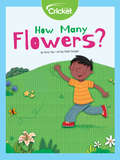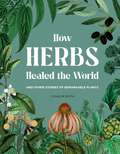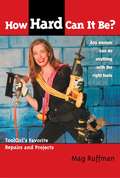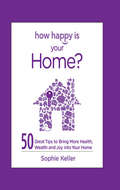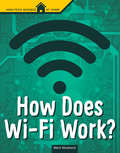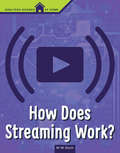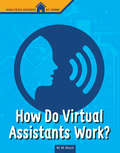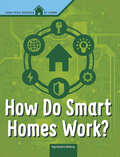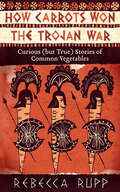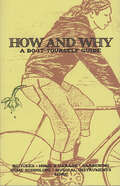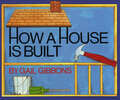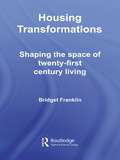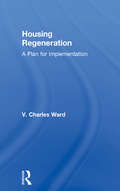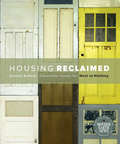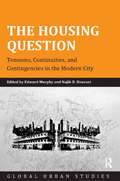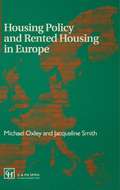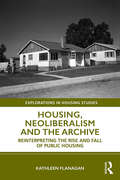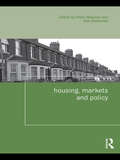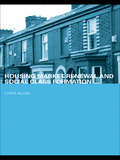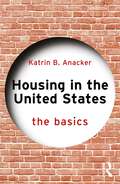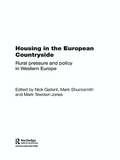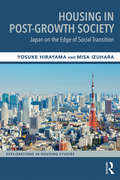- Table View
- List View
How Many Flowers
by Amy TaoDo you know how new fruit is made? Learn about the different parts of a fruit plant’s flower—the stigma, pistil, and stamen—and how they use pollen to make seeds in a process called pollination! The seeds grow into new flowers, which turn into fruit after they’re pollinated!
How Herbs Healed the World: And Other Stories of Remarkable Plants
by Connor Smith'The writing shines when recounting the stories behind these herbs, offering a blend of history and botanical fascination' - RHS, The GardenHerbs are wonderful things. Without them so much would not be possible. With the advance of science over the last two hundred years these once mystical plants have changed and saved countless lives, vastly improving our standard of living while providing us all with a much richer, healthier diet. Today, we take for granted a world full oflife-saving drugs, luxury cosmetics and exotic foods.This fascinating book will tell this story: revealing how poisons once used by the ancient Romans such as Deadly Nightshade are now being used in modern medicine or how the herbs used by indigenous people around the world have provided remedies for countless illnesses. It will explore the myths and legends behind herbs such as the infamous Mandrake and how herbs such as Yarrow are still being used to treat wounds today, just as they were thousands of years ago; and it will show how exotic herbs from across the globe have enriched our livesand delve into the origins of the culinary herbs that everyone knows and loves.Seventy-five herbs have been carefully chosen to tell the story of how they have each changed our world, looking back at their origins and what was once believed, while comparing this with the modern day uses and the scientific value of these plants enabling the reader to understand and appreciate their importance.Each double page spread will provide both historic and modern illustrations of each herb alongside captivating accounts of their historical and modern day uses including supplementary botanical and horticultural information for each.
How Herbs Healed the World: And Other Stories of Remarkable Plants
by Connor Smith'The writing shines when recounting the stories behind these herbs, offering a blend of history and botanical fascination' - RHS, The GardenHerbs are wonderful things. Without them so much would not be possible. With the advance of science over the last two hundred years these once mystical plants have changed and saved countless lives, vastly improving our standard of living while providing us all with a much richer, healthier diet. Today, we take for granted a world full oflife-saving drugs, luxury cosmetics and exotic foods.This fascinating book will tell this story: revealing how poisons once used by the ancient Romans such as Deadly Nightshade are now being used in modern medicine or how the herbs used by indigenous people around the world have provided remedies for countless illnesses. It will explore the myths and legends behind herbs such as the infamous Mandrake and how herbs such as Yarrow are still being used to treat wounds today, just as they were thousands of years ago; and it will show how exotic herbs from across the globe have enriched our livesand delve into the origins of the culinary herbs that everyone knows and loves.Seventy-five herbs have been carefully chosen to tell the story of how they have each changed our world, looking back at their origins and what was once believed, while comparing this with the modern day uses and the scientific value of these plants enabling the reader to understand and appreciate their importance.Each double page spread will provide both historic and modern illustrations of each herb alongside captivating accounts of their historical and modern day uses including supplementary botanical and horticultural information for each.
How Hard Can It Be?: Toolgirl's Favorite Repairs And Projects
by Mag Ruffman Steve Smith"You can pay big money for a self-esteem seminar, or you can buy yourself a cordless drill. I recommend the drill." Only the ToolGirl can make unplugging a blocked drain entertaining! Mag Ruffman, with characteristic flair and attitude, encourages readers to confront their terror of household maintenance and accomplish those nagging home repairs and improvements. Whether you¿re a rank beginner, first-time homeowner, or an apartment-dweller who's fed up with a lazy super, you¿ll find the know-how in this book to accomplish your goals.
How Hard Can It Be?
by Steven Smith Mag Ruffman"You can pay big money for a self-esteem seminar, or you can buy yourself a cordless drill. I recommend the drill." Only the ToolGirl can make unplugging a blocked drain entertaining! Mag Ruffman, with characteristic flair and attitude, encourages readers to confront their terror of household maintenance and accomplish those nagging home repairs and improvements. Whether you¿re a rank beginner, first-time homeowner, or an apartment-dweller who's fed up with a lazy super, you¿ll find the know-how in this book to accomplish your goals.
How Happy Is Your Home?
by Sophie KellerChange your home...for the happier.With these 50 tips, you'll learn how to apply the principles of feng shui to make your home a healthier, happier place to live. Discover:- How to bring more love in through your front door.- Simple office solutions that will increase your income.- Where to place your bed for better sex and better sleep.Take charge of your happiness, one tip at a time.
How Does Wi-Fi Work? (High Tech Science at Home)
by Mark WeaklandYou probably use Wi-Fi all the time to connect to the internet through your laptop, tablet, or phone. It's easy. Wi-Fi hotspots surround you as you go through your day - from school to a pizza place or coffee shop and then back home. Not so long ago, the internet wasn't as accessible. Find out how Wi-Fi works, how it became commonplace, and what it might do for you in the future.
How Does Streaming Work? (High Tech Science at Home)
by M. M. EbochWhether you're watching a movie, bingeing on a classic TV show, or listening to your favorite song, you're probably streaming it. Videotapes, DVDs, and CDs are mostly just memories now. Streaming puts a world of options at your fingertips when you’re at home and, with a smartphone or tablet, when you're on the go. Find out how streaming was invented, how it works, and what the future might hold for this part of a high-tech life.
How Do Virtual Assistants Work? (High Tech Science at Home)
by M. M. EbochA virtual assistant by any name - Alexa, Siri, whoever - can be a sweet addition to your home. You might use one for simple jobs like playing music or streaming podcasts. And you might use one to communicate with friends and remind you about homework coming due while helping you make your breakfast. Find out how digital assistants work and what the future might hold for this part of a high-tech home.
How Do Smart Homes Work? (High Tech Science at Home)
by Agnieszka BiskupImagine you arrive at school and realize you forgot to feed the dog. No problem. Pull out your phone and command the dog dish to dispense a serving of food. That's all there is to it - if you live a smart home. What once sounded like science fiction is now a reality for some families. People use smart phones and other devices to lock doors, turn on lights, close window shades, and check to see how much milk they have in the fridge. Find out how this technology works and what the future holds for smart homes.
How Carrots Won the Trojan War: Curious (but True) Stories of Common Vegetables
by Rebecca RuppDiscover why Roman gladiators were massaged with onion juice before battle, how celery contributed to Casanova’s conquests, how peas almost poisoned General Washington, and why some seventeenth-century turnips were considered degenerate. Rebecca Rupp tells the strange and fascinating history of 23 of the world’s most popular vegetables. Gardeners, foodies, history buffs, and anyone who wants to know the secret stories concealed in a salad are sure to enjoy this delightful and informative collection.
How and Why: A Do-It-Yourself Guide (Diy Ser.)
by Matte Resist"I dream of a better world," writes zinester andHow and Why author Matte Resist in the intro to his new book. He continues, "To me DIY culture is about grabbing a little piece of that dream." What follows over the course of the next 176 pages is Matte doing what all dreamers must do-waking up from his dream, opening his eyes, and confronting what roadblocks and hurdles lie between him and his goal. Matte does this by laying down chapter upon chapter of blueprints for a better world. A sequel to our do-it-yourself handbook Making Stuff and Doing Things, How and Why gives us detailed, engaging, easy-to-use info on bicycles, home and garage, gardening, educating children, musical instruments, and the all-inclusive "everything else" section. If you dream of taking back your life and building a better world, How and Why might be your new best friend.
How a Seed Grows (Let's-Read-and-Find-Out Science 1)
by Helene J. JordanRead and find out about how a tiny acorn grows into an enormous oak tree in this colorfully illustrated nonfiction picture book.This is a clear and appealing environmental science book for early elementary age kids, both at home and in the classroom. Plus it includes a find out more activity section with a simple experiment encouraging kids to discover what a seed needs to grow.This is a Level 1 Let's-Read-and-Find-Out, which means the book explores introductory concepts perfect for children in the primary grades. The 100+ titles in this leading nonfiction series are:hands-on and visualacclaimed and trustedgreat for classroomsTop 10 reasons to love LRFOs:Entertain and educate at the same timeHave appealing, child-centered topicsDevelopmentally appropriate for emerging readersFocused; answering questions instead of using survey approachEmploy engaging picture book quality illustrationsUse simple charts and graphics to improve visual literacy skillsFeature hands-on activities to engage young scientistsMeet national science education standardsWritten/illustrated by award-winning authors/illustrators & vetted by an expert in the fieldOver 130 titles in print, meeting a wide range of kids' scientific interestsBook in this series support the Common Core Learning Standards, Next Generation Science Standards, and the Science, Technology, Engineering, and Math (STEM) standards. Let's-Read-and-Find-Out is the winner of the American Association for the Advancement of Science/Subaru Science Books & Films Prize for Outstanding Science Series.
How a House Is Built
by Gail GibbonsHouses are built with many different materials, and in many shapes and sizes. Step by step, this picture book explains how homes are built—from the architect's plans through the arrival of a happy family. The many processes of construction are explained with simple language and bright, clear illustrations, perfect for kids starting to wonder about how the world around them works. Many different careers—including carpenters, plumbers, electricians, and landscapers—are introduced, each doing their part to bring the picture wood-frame house to life. A great read for kids who love construction sites, or who can't get enough of Building a House by Byron Barton. According to The Washington Post, Gail Gibbons "has taught more preschoolers and early readers about the world than any other children's writer-illustrator." Ms. Gibbons is the author of more than 100 books for young readers, including the bestselling titles From Seed to Plant and Monarch Butterfly. Her many honors include the Washington Post/Childrens Book Fuild Nonfiction Award and the NSTA Outstanding Science Trade Book Award.
Housing Transformations: Shaping the Space of Twenty-First Century Living (Housing and Society Series)
by Bridget FranklinDrawing together a wide range of literature, this original book combines social theory with elements from the built environment disciplines to provide insight into how and why we build places and dwell in spaces that are at once contradictory, confining, liberating and illuminating. This groundbreaking book deals with topical issues, which are helpfully divided into two parts. The first presents a conceptual framework examining how the built environment derives from a variety of influences: structural, institutional, textual, and action-orientated. Using illustrated case study examples, the second part covers new build schemes, including urban villages, gated communities, foyers, retirement homes and televillages, as well as refurbishment projects, such as mental hospitals and tower blocks. Multidisciplinary in its focus, Housing Transformations will appeal to academics, students and professionals in the fields of housing, planning, architecture and urban design, as well as to social scientists with an interest in housing.
Housing Regeneration: A Plan for Implementation
by V. Charles WardWritten from an ‘in house’ perspective in response to the UK Government Housing White Paper released in February 2017, Housing Regeneration: A Plan for Implementation presents sustainable solutions to Britain’s housing crisis and will be a useful practical guide for anyone involved in the process of regeneration. Taking as its starting point an idea for a housing regeneration scheme, it provides an overview of each of the issues to be considered and the options for addressing them. In clear and concise language, it explains the issues and work involved in a regeneration scheme, answering questions such as who is involved, how is it paid for, what options are available and, importantly, what are the risks. It will appeal to lawyers, councillors, town planners, surveyors, chief officers, finance officers, procurement officers, project managers and students, amongst others.
Housing Reclaimed
by Jessica KellnerHousing is a fundamental human right. For most of human history, our homes were built by hand from whatever local materials were available. However, since the Industrial Revolution, most housing has become little more than quickly constructed, mass-produced, uniform boxes. At the same time, the invention and standardization of the thirty-year mortgage and our ever-increasing reliance on credit has come to mean that most of us never own our homes outright.Housing Reclaimed is a call to arms for nonconventional home builders. It examines how technological advances, design evolution, and resourceful, out-of-the-box thinking about materials and efficiency can help us meet the challenge of building affordable, environmentally friendly, beautiful, and unique homes. Focusing on the use of salvaged and reclaimed materials, this inspirational volume is packed with case studies of innovative projects including:*Phoenix Commotion-working together towards low-income home ownership through sweat equity and 100 percent recycled materials*HabeRae-revitalizing neighborhoods by creating urban infill using modern technology and sustainable and reclaimed materials*Builders of Hope-rescuing and rehabilitating whole houses slated for demolitionThese projects and others like them demonstrate that building one's own home does not have to be an unattainable dream. This beautifully illustrated guide is a must-read for anyone interested in creating quality zero- or low-debt housing, reducing landfill waste, and creating stronger communities.Jessica Kellner is the editor of Natural Home and Garden magazine and a passionate advocate of using architectural salvage to create aesthetically beautiful, low-cost housing.
The Housing Question: Tensions, Continuities, and Contingencies in the Modern City (Global Urban Studies)
by Edward Murphy Najib B. HouraniIn the wake of the Great Recession, housing and its financing suddenly re-emerged as questions of significant public concern. Yet both public and academic debates about housing have remained constricted, tending not to explore how the evolution of housing simultaneously entails basic forms of socio-spatial reproduction and underlying tensions in the political order. Drawing on cutting edge perspectives from urban studies, this book grants renewed, interdisciplinary energy to the housing question. It explores how housing raises a series of vexing issues surrounding rights, identity, and justice in the modern city. Through finely detailed studies that illuminate national and regional particularities- ranging from analyses of urban planning in the Soviet Union, the post-Katrina reconstruction of New Orleans, to squatting in contemporary Lima - the volume underscores how housing questions matter in a wide range of contexts. It draws attention to ruptures and continuities between high modernist and neoliberal forms of urbanism, demonstrating how housing and the dilemmas surrounding it are central to governance and the production of space in a rapidly urbanizing world.
Housing Policy and Rented Housing in Europe
by Michael Oxley Jaqueline SmithThe book will inform a wide audience about the provision of rented housing in several European countries. The material is relevant to many housing, surveying and planning undergraduate and postgraduate courses which have a European housing element/option.
Housing, Neoliberalism and the Archive: Reinterpreting the Rise and Fall of Public Housing (Explorations in Housing Studies)
by Kathleen FlanaganFrom the mid-1940s, state housing authorities in Australia built large housing estates to enable home ownership by working-class families, but the public housing system they created is now regarded as broken. Contemporary problems with the sustainability, effectiveness and reputation of the Australian public housing system are usually attributed to the influence of neoliberalism. Housing, Neoliberalism and the Archive offers a challenge to this established ‘rise and fall’ narrative of post-war housing policy. Kathleen Flanagan uses Foucauldian ‘archaeology’ to analyse archival evidence from the Australian state of Tasmania. Through this, she reveals that the difference between past and present knowledge about the value, role and purpose of public housing results from a significant discontinuity in the way we think and act in relation to housing policy. Flanagan describes the complex system of ideas and events that underpinned policy change in Tasmania while telling a story about state housing policy, neoliberalism and history that has resonance for many other places and times. In the process, she shows that the story of public housing is more complicated than the taken-for-granted neoliberal narrative and that this finding has real significance for the dilemmas in public housing policy that face us in the here and now.
Housing, Markets and Policy (Housing and Society Series)
by Peter Malpass Rob RowlandsThis book of specially commissioned essays by distinguished housing scholars addresses the big issues in contemporary debates about housing and housing policy in the UK. Setting out a distinctive and coherent analysis, it steers a course between those accounts that rely on economic theory and analysis and those that emphasize policy. It is informed by the idea that the 1970s was a pivotal decade in the second half of the twentieth century, and that since that time there has been a profound transformation in the housing system and housing policy in the UK. The contributors describe, analyze and explain aspects of that transformation, as a basis for understanding the present and thinking about the future. The analysis of housing is set within an understanding of the wider changes affecting the economy and the welfare state since the crises of the mid 1970s.
Housing Market Renewal and Social Class (Housing, Planning and Design Series)
by Chris AllenHousing market renewal is one of the most controversial urban policy programmes of recent years. Housing Market Renewal and Social Class critically examines the rationale for housing market renewal: to develop 'high value' housing markets in place of the so-called 'failing markets' of low-cost housing. Whose interests are served by such a programme and who loses out? Drawing on empirical evidence from Liverpool, the author argues that housing market renewal plays to the interests of the middle classes in viewing the market for houses as a field of social and economic 'opportunities', a stark contrast to a working class who are more concerned with the practicalities of 'dwelling'. Against this background of these differing attitudes to the housing market, Housing Market Renewal and Social Class explores the difficult question of whether institutions are now using the housing market renewal programme to make profits at the expense of ordinary working-class people. Reflecting on how this situation has come about, the book critically examines the purpose of current housing market renewal policies, and suggests directions for interested social scientists wishing to understand the implications of the programme. Housing Market Renewal and Social Class provides a unique phenomenological understanding of the relationship between social class and the market for houses, and will be compelling reading for anybody concerned with the situation of working class people living in UK cities.
Housing in the United States: The Basics (The Basics)
by Katrin B. AnackerHousing matters to people, be they owner, renter, housing provider, homeless individual, housing professional, or policymaker. Housing in the United States: The Basics offers an accessible introduction to key concepts and issues in housing—and a concise overview of the programs that affect housing choices, affordability, and access in the United States today. Part I covers the fundamentals of housing: households, housing units, and neighborhoods; housing as basic need vs. human right; supply and demand; construction, rehabilitation, and renovation; and demographic, socioeconomic, and cultural trends. Part II focuses on housing policy and its evolution from the early 20th century, through the Great Recession to the present day; policies related to owner- and renter-occupied housing; tax policies and expenditures; place- and people-based programs; and shortages of affordable housing.Written in a clear and engaging style, this guide allows readers to quickly grasp the complex range of policies, programs, and factors that shape the housing landscape. Essential reading for students, community advocates, homebuyers/renters, and professionals with an interest in housing, it also serves as an ideal text for introductory courses in urban planning, urban studies, sociology, public administration, architecture, and real estate.This book provides a valuable and practical foundation for informed housing discussions at the kitchen table, in the classroom, at work, or on Capitol Hill.
Housing in the European Countryside: Rural Pressure and Policy in Western Europe (Housing, Planning and Design Series)
by Nick Gallent Mark Shucksmith Mark Tewdwr-JonesHousing in the European Countryside provides an overview of the housing pressures and policy challenges facing Europe, while highlighting critical differences. By drawing on contemporary research work of leading authors in the fields of housing studies, rural geography and planning, the book provides an introduction to housing issues across the European countryside for those who have hitherto been unexposed to such concerns, and who wish to gain some basic insight. This in-depth review of housing pressure in the European countryside reveals both the form, nature and variety of problems now being experienced in different parts of Europe, in addition to outlining policy solutions that are being provided by member states and other agencies in meeting the rural housing challenge at this time and in the years ahead.
Housing in Post-Growth Society: Japan on the Edge of Social Transition (Explorations in Housing Studies)
by Yosuke Hirayama Misa IzuharaIn a globalising world, many mature economies share post-growth characteristics such as low economic growth, low fertility, declining and ageing of the population and increasing social stratification. Japan stands at the forefront of such social change in the East Asian region as well as in the Global North. It is in this context of ‘post-growth society’ that housing issues are examined, using the experiences of Japan at the leading edge of social transition in the region. The post-war housing system was developed during the golden age of economy and welfare, when upward social trajectories such as increasing population, high-speed economic growth with rising real incomes, housing construction driven by high demands, increasing rates of home ownership supported by generous government subsidies generated new housing opportunities and accompanying issues. As we have entered the post-growth phase of socio-economic development, however, it requires a re-examination of such structure, policy and debates. This volume explores what roles housing plays in the reorganisation and reconstruction of economic processes, social policy development, ideology and identity, and intergenerational relations. The volume offers a greater understanding of the characteristics of post-growth society – changing demography, economy and society – in relation to housing. It considers how a definitive shift to the post-growth period has produced new housing issues including risks as well as opportunities. Through analysis of the impact on five different areas: post-crisis economy, urban and regional variations, young adults and housing pathways, fertility and housing, and ageing and housing wealth, the authors use policy and institutions as overarching analytical tools to examine the contemporary housing issues in a post-growth context. It also considers any relevance from the Japanese experiences in the wider regional and global context. This original book will be of great interest to academics and students as well as policy makers and practitioners internationally in the fields of housing studies, urban studies, social policy, sociology, political economy, comparative analysis, and East Asian Studies.
